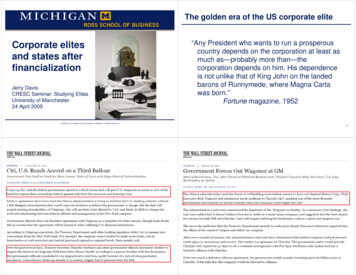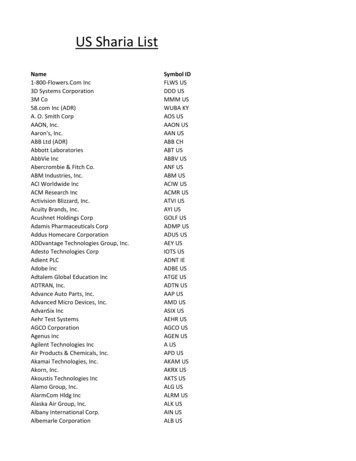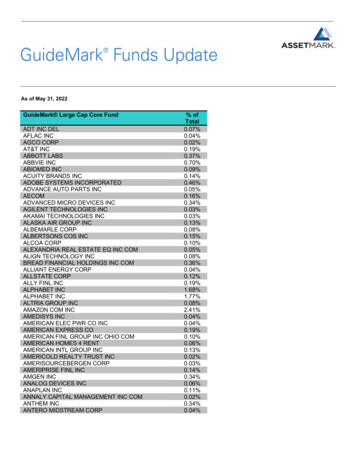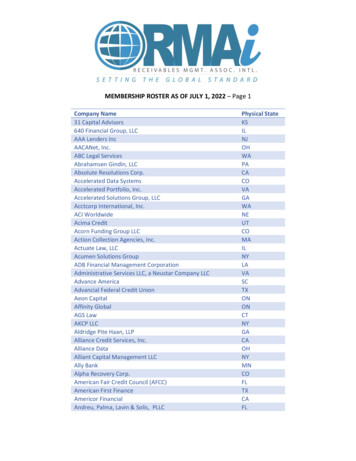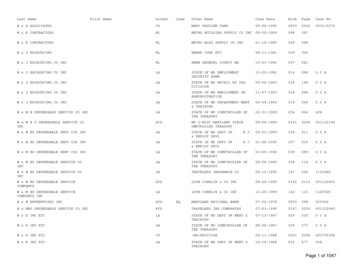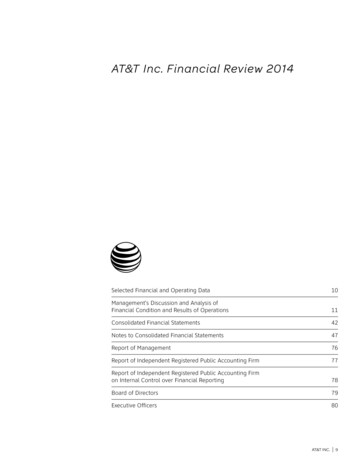
Transcription
AT&T Inc. Financial Review 2014Selected Financial and Operating Data10Management’s Discussion and Analysis ofFinancial Condition and Results of Operations11Consolidated Financial Statements42Notes to Consolidated Financial Statements47Report of Management76Report of Independent Registered Public Accounting Firm77Report of Independent Registered Public Accounting Firmon Internal Control over Financial Reporting78Board of Directors79Executive Officers80AT&T INC. 9
Selected Financial and Operating DataDollars in millions except per share amountsAt December 31 and for the year ended:Financial DataOperating revenuesOperating expensesOperating incomeInterest expenseEquity in net income of affiliatesOther income – netIncome tax expense (benefit)Net IncomeLess: Net Income Attributable toNoncontrolling InterestNet Income Attributable to AT&TEarnings Per Common Share:Net Income Attributable to AT&TEarnings Per Common Share – Assuming Dilution:Net Income Attributable to AT&TTotal assetsLong-term debtTotal debtConstruction and capital expendituresDividends declared per common shareBook value per common shareRatio of earnings to fixed chargesDebt ratioWeighted-average common shares outstanding (000,000)Weighted-average common sharesoutstanding with dilution (000,000)End of period common shares outstanding (000,000)Operating DataWireless subscribers (000)1In-region network access lines in service (000)Broadband connections (000)2Number of employees122014201320122011 132,447 120,701 11,746 3,613 175 1,652 3,442 6,518 128,752 98,273 30,479 3,940 642 596 9,224 18,553 127,434 114,437 12,997 3,444 752 134 2,900 7,539 126,723 117,505 9,218 3,535 784 249 2,532 4,184 124,280 104,707 19,573 2,994 762 897 (1,162) 20,179 (294) 6,224 (304) 18,249 (275) 7,264 (240) 3,944 (315) 19,864 1.19 3.39 1.25 0.66 3.36 1.19 3.39 1.25 0.66 3.35 292,829 76,011 82,067 21,433 1.85 16.762.8348.6%5,205 277,787 69,290 74,788 21,228 1.81 17.505.9845.0%5,368 272,315 66,358 69,844 19,728 1.77 16.612.9643.0%5,801 270,442 61,300 64,753 20,272 1.73 17.852.2338.0%5,928 269,473 58,971 66,167 20,302 1.69 ,590The number presented represents 100% of AT&T Mobility wireless subscribers.Broadband connections include in-region U-verse high speed Internet access, in-region DSL lines and satellite broadband.10 AT&T INC.2010
Management’s Discussion and Analysis of Financial Condition and Results of OperationsDollars in millions except per share amountsFor ease of reading, AT&T Inc. is referred to as “we,” “AT&T” or the “Company” throughout this document, and the namesof the particular subsidiaries and affiliates providing the services generally have been omitted. AT&T is a holding companywhose subsidiaries and affiliates operate in the communications services industry in both the United States andinternationally, providing wireless and wireline telecommunications services and equipment. You should read this discussionin conjunction with the consolidated financial statements and accompanying notes. A reference to a “Note” in this sectionrefers to the accompanying Notes to Consolidated Financial Statements. In the tables throughout this section, percentageincreases and decreases that are not considered meaningful are denoted with a dash.RESULTS OF OPERATIONSConsolidated Results Our financial results are summarized in the table below. We then discuss factors affecting ouroverall results for the past three years. These factors are discussed in more detail in our “Segment Results” section.We also discuss our expected revenue and expense trends for 2015 in the “Operating Environment and Trends of theBusiness” section.Percent ChangeOperating RevenuesServiceEquipmentTotal Operating RevenuesOperating ExpensesCost of services and salesSelling, general and administrativeAbandonment of network assetsDepreciation and amortizationTotal Operating ExpensesOperating IncomeInterest expenseEquity in net income of affiliatesOther income (expense) – netIncome Before Income TaxesNet IncomeNet Income Attributable to AT&T2014 vs.2013201420132012 118,43714,010132,447 119,2529,500128,752 8,273120,70111,7463,6131751,6529,9606,518 4259627,77718,553 410,4397,539 �(64.1)(64.9)(65.9)%OVERVIEWOperating income decreased 18,733, or 61.5%, in 2014and increased 17,482 in 2013. Our operating margin was8.9% in 2014, compared to 23.7% in 2013 and 10.2% in2012. Operating income for 2014 decreased 15,453 dueto a noncash actuarial loss of 7,869 related to pensionand postemployment benefit plans and an actuarial gainof 7,584 in 2013. Operating income for 2014 alsoincludes a noncash charge of 2,120 related to anabandonment of network assets, higher wireless equipmentcosts resulting from higher device sales, increasedexpenses supporting AT&T U-verse (U-verse) subscribergrowth, and continued declines in our traditional voiceand data services. Partially offsetting these decreaseswere continued growth in wireless equipment revenuefor device sales under our AT&T NextSM (AT&T Next)program and increased revenues from U-verse andstrategic business services, as well as the operating2013 .6)————results of Leap Wireless International, Inc. (Leap) fromMarch 13, 2014. Operating income for 2013 included anoncash actuarial gain of 7,584 related to pension andpostemployment benefit plans in 2013 and operatingincome for 2012 included an actuarial loss of 9,994.Service revenues decreased 815, or 0.7%, in 2014 andincreased 746, or 0.6%, in 2013. The decrease in 2014was primarily due to growth in our wireless Mobile ShareValue plans, continued declines in our legacy wireline voiceand data products and the October 2014 sale of ourConnecticut operations (see Note 5), partially offset bystrong revenues from U-verse, strategic business servicesand revenues from the acquisition of Leap. The revenueincrease in 2013 was primarily due to growth in wirelessdata billings, reflecting the increasing percentage ofwireless subscribers choosing smartphones and higherwireline revenues from U-verse residential customers andstrategic business services. These increases were mostlyAT&T INC. 11
Management’s Discussion and Analysis of Financial Condition and Results of Operations (continued)Dollars in millions except per share amountsoffset by continued declines in revenues from legacywireline voice and data services and the loss of revenuesresulting from the sale of our Advertising Solutionssegment in 2012.The telecommunications industry is rapidly evolving fromfixed location, voice-oriented services into an industrydriven by customer demand for instantly available, databased services (including video). We have been investingheavily to expand our broadband network and upgradeour wireless network to meet this demand. We have alsolaunched new wireless offerings to give our customersadditional choices for data and handset purchase plans.Equipment revenues increased 4,510, or 47.5%, in 2014and 572, or 6.4%, in 2013. Growth in equipment revenuesreflected the continuing trend by our postpaid wirelesssubscribers to choose devices on installment purchaserather than the device subsidy model, which resulted inincreased equipment revenue recognized for device sales.The revenue increase in 2013 was primarily due to growthin wireless equipment revenues, reflecting the increasingpercentage of wireless subscribers choosing smartphones.Cost of services and sales expenses increased 9,147,or 17.8%, in 2014 and decreased 3,764, or 6.8%, in 2013.The 2014 expense increased by 4,406 as a result ofrecording actuarial losses in 2014 and actuarial gains in2013. Wireless handset sales and upgrades contributedto higher equipment costs and handset insurance costs in2014. The increase also reflects higher wireless networkcosts and wireline costs attributable to U-verse contentcosts and subscriber growth and employee-related charges.The 2013 expense decreased by 4,822 as a result ofrecording actuarial gains in 2013 and losses in 2012.Lower interconnect and long-distance expenses, lower costsassociated with Universal Service Fund (USF) fees and thesale of our Advertising Solutions segment also contributedto expense declines in 2013. These decreases were partiallyoffset by increased wireless equipment costs related todevice sales and increased wireline costs attributable togrowth in U-verse subscribers.Selling, general and administrative expenses increased 11,283, or 39.7%, in 2014 and decreased 12,652, or30.8%, in 2013. The 2014 expense increased by 11,047as a result of recording actuarial losses in 2014 andactuarial gains in 2013. Expense increases in 2014 alsoreflect higher selling and administrative expenses in ourWireless segment and gains on spectrum transactionsin 2013. These increases were partially offset by loweremployee-related costs and Wireless commissions expenses.12 AT&T INC.The 2013 expense decreased by 12,757 as a result ofrecording actuarial gains in 2013 and actuarial lossesin 2012. Expense reductions in 2013 also reflect loweremployee-related Wireline costs, gains on spectrumtransactions, lower financing-related costs associatedwith our pension and postretirement benefits (referredto as Pension/OPEB expenses) and the sale of ourAdvertising Solutions segment. These decreases werepartially offset by increased charges for employeeseparations and higher selling and advertising expenses.Abandonment of network assets In 2014, we recordeda noncash charge of 2,120 for the abandonment in placeof certain network assets (see Note 6). During the fourthquarter of 2014, we completed a study of our networkassets and determined that specific copper assets will notbe necessary to support future network activity, due todeclining customer demand for our legacy voice and dataproducts and the transition of our networks to nextgeneration IP-based technology.Depreciation and amortization expense decreased 122, or 0.7%, in 2014 and increased 252, or 1.4%, in2013. The 2014 expense decrease was primarily due toextending the estimated useful life of software, anincrease in fully depreciated assets and lower amortizationof intangibles for customer lists. These decreases werelargely offset by ongoing capital spending for networkupgrades and expansion and additional expense associatedwith the assets acquired from Leap.The 2013 expense increase was primarily due to ongoingcapital spending for network upgrades and expansion,partially offset by fully depreciated assets and loweramortization of intangibles for customer lists and thesale of our Advertising Solutions segment.Interest expense decreased 327, or 8.3%, in 2014 andincreased 496, or 14.4%, in 2013. The decrease in 2014was primarily due to a 581 charge related to debt tenderoffers in 2013 and lower interest rates resulting fromrefinancing activity, partially offset by interest expenserelated to our December 2013 tower transaction (seeNote 17), higher debt balances and charges associatedwith the early redemption of debt during 2014.The increase in interest expense for 2013 was primarilydue to a 581 charge related to our debt tender offersin 2013, partially offset by charges associated with earlydebt redemptions in 2012. Lower average interest ratesoffset higher average debt balances.
Equity in net income of affiliates decreased 467, or72.7%, in 2014 and 110, or 14.6%, in 2013. The decreasein 2014 primarily resulted from the sale of our investmentin América Móvil, S.A. de C.V. (América Móvil) in June 2014(see Note 5). Lower earnings from YP Holdings LLC(YP Holdings) and our investment in the mobile paymentjoint venture SoftcardTM (Softcard) also contributed to lowerequity in net income of affiliates in 2014. The decrease in2013 was due to lower earnings from América Móvil andincreased expenses in Softcard, partially offset by increasedearnings from YP Holdings.América MóvilYP HoldingsSoftcardOtherEquity in Net Income of Affiliates201420132012 153134(112)— 175 532182(75)3 642 686130(62)(2) 752Other income (expense) – net We had other income of 1,652 in 2014, 596 in 2013 and 134 in 2012. Results for2014 included a combined net gain of 1,541 on the saleof América Móvil shares, our Connecticut operations andother investments, interest and dividend income of 68,and leveraged lease income of 29.Other income for 2013 included a net gain on the sale ofAmérica Móvil shares and other investments of 498,interest and dividend income of 68, and leveraged leaseincome of 26. Results for 2012 included net gains on thesale of investments of 74, interest and dividend incomeof 61, and leveraged lease income of 55. This incomewas partially offset by 57 of investment impairments.Income tax expense decreased 5,782 in 2014 andincreased 6,324 in 2013. The decrease in 2014 andincrease in 2013 were primarily due to a change in incomebefore income taxes. Our effective tax rate was 34.6% in2014, 33.2% in 2013 and 27.8% in 2012 (see Note 11).Segment ResultsOur segments are strategic business units that offerdifferent products and services over various technologyplatforms and are managed accordingly. Our operatingsegment results presented in Note 4 and discussed belowfor each segment follow our internal managementreporting. We analyze our operating segments based onsegment income before income taxes. We make our capitalallocation decisions based on the strategic needs of thebusiness, needs of the network (wireless or wireline)providing services and to provide emerging services toour customers. Actuarial gains and losses from pensionand other postemployment benefits, interest expense andother income (expense) – net, are managed only on atotal company basis and are, accordingly, reflected onlyin consolidated results. Therefore, these items are notincluded in each segment’s percentage of our totalsegment income. Each segment’s percentage of totalsegment operating revenue and income calculations isderived from our segment results, and income percentagemay total more than 100 percent due to losses in oneor more segments. We have two reportable segments:(1) Wireless and (2) Wireline. Our operating results priorto May 9, 2012, also included our sold Advertising Solutionssegment (see Note 5).The Wireless segment accounted for approximately 56%of our 2014 total segment operating revenues as comparedto 54% in 2013 and 75% of our 2014 total segment incomeas compared to 74% in 2013. This segment uses ournationwide network to provide consumer and businesscustomers with wireless data and voice communicationsservices. This segment included our portion of the resultsfrom our equity investment in Softcard.The Wireline segment accounted for approximately 44%of our 2014 total segment operating revenues as comparedto 46% in 2013 and 25% of our 2014 total segment incomeas compared to 26% in 2013. This segment usesour regional, national and global network to provideconsumer and business customers with data and voicecommunications services, U-verse high speed Internet,video and VoIP services and managed networking tobusiness customers.The following sections discuss our operating results bysegment. Operations and support expenses include certainnetwork planning and engineering expenses; informationtechnology; our repair technicians and repair services;property taxes; bad debt expense; advertising costs; salesand marketing functions, including customer servicecenters; real estate costs, including maintenance andutilities on all buildings; credit and collection functions;and corporate support costs, such as finance, legal,human resources and external affairs. Pension andpostretirement service costs, net of amounts capitalizedas part of construction labor, are also included to theextent that they are associated with employees whoperform these functions.We discuss capital expenditures for each segment in“Liquidity and Capital Resources.”AT&T INC. 13
Management’s Discussion and Analysis of Financial Condition and Results of Operations (continued)Dollars in millions except per share amountsWirelessSegment ResultsPercent ChangeSegment operating revenuesServiceEquipmentTotal Segment Operating RevenuesSegment operating expensesOperations and supportDepreciation and amortizationTotal Segment Operating ExpensesSegment Operating IncomeEquity in Net Income (Loss) of AffiliatesSegment Income2014 vs.20132013 vs.2012201420132012 61,03212,96073,992 61,5528,34769,899 4156,86517,127(112) 17,01544,5087,46851,97617,923(75) 17,84843,2966,87350,16916,594(62) 8.0%The following table highlights other key measures of performance for the Wireless segment:Percent Change(in 000s)Wireless Subscribers1Postpaid smartphonesPostpaid feature phones and data-centric devicesPostpaidPrepaidResellerConnected devices2Total Wireless SubscribersNet Additions3PostpaidPrepaidResellerConnected devices2Net Subscriber AdditionsMobile Share connectionsSmartphones sold under our installmentprogram during periodTotal Churn4Postpaid Churn42014 vs.20132013 1.45%1.04%1,5401.37%1.06%—1.35%1.09%—8 BP(2) BP—2 BP(3) BP3,290(775)(346)3,4395,608Represents 100% of AT&T Mobility wireless subscribers. Includes data-centric devices (e.g., monitoring devices and automobile systems). Excludes tablets, which are primarily included in postpaid.3 Excludes merger and acquisition-related additions during the period.4 Calculated by dividing the aggregate number of wireless subscribers who canceled service during a period divided by the total number of wireless subscribers at thebeginning of that period. The churn rate for the period is equal to the average of the churn rate for each month of that period.12Subscriber RelationshipsAs the wireless industry continues to mature, we believe thatfuture wireless growth will increasingly depend on our abilityto offer innovative services, plans and devices and a wirelessnetwork that has sufficient spectrum and capacity to supportthese innovations on as broad a geographic basis as possible.To attract and retain subscribers in a maturing market, wehave launched a wide variety of plans, including Mobile Shareand Mobile Share Value (Mobile Share) and AT&T Next.While we have historically focused on attracting and14 AT&T INC.retaining postpaid subscribers, we have recently increasedour focus on prepaid subscribers with our acquisition of Leap,which operates under the Cricket brand.At December 31, 2014, we served 120.6 million subscribers(including Cricket subscribers from our March 13, 2014acquisition of Leap, which were approximately 4.5 millionat closing), an increase of 9.2% from the prior year.Our subscriber base consists primarily of postpaid accounts.Our prepaid services, which include results from servicessold under the Cricket brand, are monthly prepaid services.
ARPUIn 2014, our wireless business, and to some extent, thewireless industry, underwent a transformation in howsubscribers purchase services and devices. The rapidexpansion in the number of our subscribers who purchaseequipment on installment and choose Mobile Share Valuepricing, which offers lower prices for having multipledevices (including tablets) sharing services on one billingaccount, has highlighted the shortcomings of using thetraditional metric of ARPU (average revenue per averagewireless subscribers) to measure the economic value of acustomer to a carrier. By relying only on monthly revenue,ARPU does not capture the total payments made by acustomer. We believe that postpaid phone-only subscriberrevenue per average user plus Next subscriber installmentbillings (postpaid phone-only ARPU plus AT&T Next) is abetter representation of the monthly economic value perpostpaid subscriber. For 2014, postpaid phone-only ARPUdecreased 6.6% and postpaid phone-only ARPU plus AT&TNext decreased 2.6% compared to 2013. Postpaid phoneonly ARPU increased 2.9% in 2013 as a result of a greateruse of smartphones by our subscribers. AT&T Next, whichlaunched later in 2013, did not have a significant impactprior to 2014.ChurnThe effective management of subscriber churn is critical toour ability to maximize revenue growth and to maintain andimprove margins. Total churn was higher in 2014 and 2013due to increased competition and the expected pressurein prepaid with the transition of former Leap customers.Postpaid churn was lower for both 2014 and 2013.PostpaidPostpaid subscribers increased 4.5% and 3.0% in 2014and 2013, respectively. At December 31, 2014, 83% ofour postpaid phone subscriber base used smartphones,compared to 77% at December 31, 2013 and 70% atDecember 31, 2012. About 97% of our postpaidsmartphone subscribers are on plans that provide forservice on multiple devices at reduced rates, and suchsubscribers tend to have higher retention and lower churnrates. A growing percentage of our postpaid smartphonesubscribers are on usage-based data plans, withapproximately 85% on these plans as compared to 75%and 67%, respectively, in the prior two years. About 50%of our Mobile Share accounts have chosen plans with10 gigabytes or higher. Device connections on our MobileShare plans now represent almost 70% of our postpaidcustomer base. Such offerings are intended to encourageexisting subscribers to upgrade their current servicesand/or add connected devices, attract subscribers fromother providers and minimize subscriber churn.As of December 31, 2014, approximately 90% of ourpostpaid smartphone subscribers use a 4G-capable device(i.e., a device that would operate on our LTE or HSPA network), and about 75% of our postpaid smartphonesubscribers use an LTE device.Historically, our postpaid customers have signed two-yearservice contracts when they purchase subsidized handsets.However, through our Mobile Share plans, we have recentlybegun offering postpaid services at lower prices for thosecustomers who either bring their own devices (BYOD) orparticipate in our AT&T Next program. Approximately 52%of all postpaid smartphone gross adds and upgradesduring 2014 chose AT&T Next. We also experienced a sharprise in the number of BYOD gross adds during 2014 toapproximately 1,492,000, compared to approximately400,000 in 2013. While BYOD customers do not generateequipment revenue, the lack of a device cost and subsidyhelps improve our margins. We expect continued increasesin our AT&T Next take rate as we have expanded theprogram to additional distributors.Our AT&T Next program allows for postpaid subscribers topurchase certain devices in installments over a period ofup to 30 months. Additionally, after a specified period oftime, they also have the right to trade in the original devicefor a new device and have the remaining unpaid balancesatisfied. For customers that elect these trade-in programs,at the time of the sale, we recognize equipment revenuefor the amount of the customer receivable, net of the fairvalue of the trade-in right guarantee and imputed interest.A significant percentage of our customers on the AT&T Nextprogram pay a lower monthly service charge, which resultsin lower service revenue recorded for these subscribers.In the second quarter of 2014, we began offering the AT&TNext program through other distributors and we expandedthe offering to almost all of our remaining distributorsduring the third quarter, which further accelerated theimpacts on service revenues.PrepaidIn March 2014, we completed our acquisition of Leap, whichincluded approximately 4.5 million prepaid subscribers atclosing. Since the acquisition, prepaid subscribers havedecreased approximately 7.0% due in part to the expectedtransition of Cricket subscribers.Operating ResultsOur Wireless segment operating income margin was 23.1%in 2014, compared to 25.6% in 2013 and 24.9% in 2012.Our Wireless segment operating income decreased 796,or 4.4%, in 2014 and increased 1,329, or 8.0%, in 2013.The decreases in operating margin and income in 2014reflected the increasing popularity of Mobile Share plans,promotional activities and our continued investment in newservices. The operating income and margin increase in 2013reflected continuing data revenue growth and operatingefficiencies, partially offset by high subsidies associatedwith growing smartphone sales.Service revenues decreased 520, or 0.8%, in 2014 andincreased 2,366, or 4.0%, in 2013. The decrease in 2014was largely due to customers shifting to no-device-subsidyplans, which allow for discounted monthly service chargesAT&T INC. 15
Management’s Discussion and Analysis of Financial Condition and Results of Operations (continued)Dollars in millions except per share amountsunder our Mobile Share plans. This decrease was largelyoffset by revenues from Cricket subscribers that were notincluded in our 2013 results. The increase in 2013 wasprimarily due to a higher number of subscribers usingsmartphones and data-centric devices. While we expectmonthly service revenues to continue to be pressuredas customers move to Mobile Share plans, we expectequipment revenues to increase for those subscriberswho elect the AT&T Next program.Equipment revenues increased 4,613, or 55.3%, in 2014and 770, or 10.2%, in 2013. The increase in 2014 wasprimarily related to the increase in devices sold under ourAT&T Next program and also the increase in smartphonesales and sales to Cricket customers. During the secondquarter of 2014, with the launch of the AT&T Next programthrough other distributors, we began deferring therecognition of equipment revenue and costs on sales todistributors until the device is sold to the end subscriberand the trade-in right is conveyed. This lag in timing of therecognition of the sale resulted in lower revenue throughthese distributors beginning in the second quarter of 2014.The increase in 2013 was primarily driven by the increasednumber of smartphones as a percentage of total devicesales to postpaid subscribers.Operations and support expenses increased 4,416, or9.9%, in 2014 and 1,212, or 2.8%, in 2013. The increase in2014, which includes the incremental costs related tointegrating Leap, was primarily due to the following: Equipment costs increased 2,664, reflecting the salesof more expensive smartphones. Equipment costs alsoinclude Cricket and Alltel subscriber integration charges,which we expect will continue into 2015 as we completethe migration of those subscribers to our network. Selling (other than commissions) and administrativeexpenses increased 1,060 due primarily to increasesof: 261 in sales and marketing expense; 279 inprofessional, administrative and legal costs; 252 incustomer service and retention cost; and 125 inbad debt expense resulting from higher volumesof equipment installment sales. Network system costs increased 578 due toincreased lease fees, higher maintenance and energycosts resulting from the increase in the numberof cell sites and expenses related to our networkenhancement efforts. These increases were partiallyoffset by lower interconnect costs resulting fromour ongoing network transition to more efficientEthernet/IP-based technologies. Handset insurance cost increased 407 due to anincrease in the cost of replacement phones.Partially offsetting these increases were lower commissionexpenses of 486, which were primarily due to lower averagecommission rates paid under the AT&T Next program as well16 AT&T INC.as a decrease in national equipment activation credits.These decreases are partially offset by an increase dueto Cricket, postpaid gross activations and upgrades.The increase in 2013 was primarily due to the following: Equipment costs increased 817, reflecting salesof more expensive smartphones, partially offset bythe overall decline in upgrade activity and totaldevice sales. Selling expenses (other than commissions) andadministrative expenses increased 712 due primarilyto a 265 increase in employee-related costs, a 246 increase in advertising costs, 187 increase ininformation technology costs in conjunction withongoing support systems development, and 107increase in nonemployee-related costs, partiallyoffset by an 84 decrease in bad debt expense. Commission expenses increased 59 due to a yearover-year increase in smartphone sales as apercentage of total device sales, partially offset bythe overall decline in handset upgrade activity andtotal device sales.Partially offsetting these increases were the following: Long-distance costs decreased 130 due to third-partycredits and lower usage costs. USF fees decreased 104 primarily due to USF ratedecreases, which are offset by lower USF revenues. Network system costs decreased 77 primarily dueto lower interconnect costs partially offset by highernetwork traffic, personnel-related network supportcosts and cell site related costs in conjunction withour network enhancement efforts. Incollect roaming fees decreased 73 primarily dueto rate declines and lower roaming use associatedwith the integration of previously acquired subscribersinto our network.Depreciation and amortization expenses increased 473,or 6.3%, in 2014 and 595, or 8.7%, in 2013. In 2014,depreciat
March 13, 2014. Operating income for 2013 included a noncash actuarial gain of 7,584 related to pension and postemployment benefit plans in 2013 and operating income for 2012 included an actuarial loss of 9,994. Service revenues decreased 815, or 0.7%, in 2014 and increased 746, or 0.6%, in 2013. The decrease in 2014

